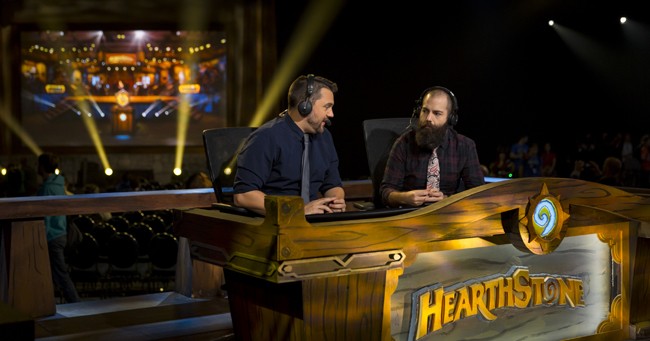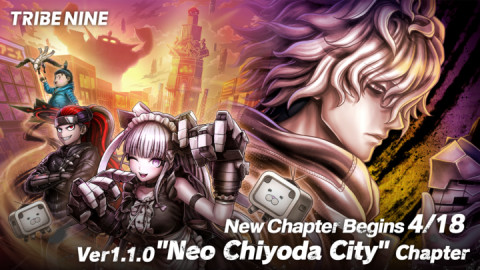
Competitive Hearthstone has come a long way since the game’s launch. Blizzard quickly embraced the community’s passion for the game’s competitive side, allowing for a rapid growth in popularity on top of the already existing craze. From invitational tournaments and a relatively small group of core players competing at the top, Hearthstone’s esports scene has evolved into a global competition.
With Hearthstone’s competitive player base, prize money and event structure constantly changing and expanding, so too has casting in Hearthstone developed over the years. From a bumpy start, with everyone getting used to a whole new esports genre amidst MOBAs, FPS, and FGC, there now is a clear vision of how a digital collectible card game should be narrated.
In the scene’s solar system, three duos fly closest to the sun that is Hearthstone Esports casting. Brian Kibler & Dan “Frodan” Chou, TJ Sanders & Nathan “ThatsAdmirable” Zamora and Simon “Sottle” Welch & Alexander “Raven” Baguley are the fixed six for HCT Seasonal Championships. Not only that, they often play a part in other Hearthstone Esports tournaments. Sottle and Raven took care of HCT Germany just a few weeks ago and coming weekend Frodan and TJ Sanders will be present at HCT Toronto.
But these six are far from the only active casters. Sticking to the solar system metaphor for Hearthstone Esports’ casting, there is a large group of casters floating around just beyond the asteroid belt. Casters like Neil “L0rinda” Bond, Daniel “Falcone” “Falcone and Cora “Songbird” Georgiou were the faces of Hearthstone’s Global Games in 2017, and pick up the English casting for many events such as Copa América. And it doesn’t end there. Darroch Brown, Jia Dee, Jakub “Lothar” Szygulski and many others tell the audience exactly what’s happening during a match. The list is long.
However, despite the progress Hearthstone casting has made over the years, one specific feature hasn’t seen the light of day for far too long: a dedicated analyst desk.

Numerous numbers
The absence of an analyst desk at Hearthstone events is mind-boggling when you give it a little thought. Of all popular esports, it’s safe to say Hearthstone requires the most analytical mind to perform well in. In titles such as CS:GO, Dota 2, League of Legends, Overwatch and Rocket League physical skill is combined with strategies to various degrees. But in Hearthstone, it’s all about math.
There are hundreds of cards that can be combined in millions of ways to form decks, and only a few can secure a victory. During a match each top-level player is constantly assessing the probabilities of which cards can be drawn, which cards the opponent has in their hand and which cards are still in the opponent’s deck. Based on the information received a strategy is formed, one that’s constantly adapting to new information obtained throughout the match.
Each aforementioned popular esports has an analyst desk at their big tournaments. Yet Hearthstone sits without a desk that dives into the match and picks it apart before and after the clash.
The long list of Hearthstone casters consists of exactly that: casters. And although casting in Hearthstone naturally leans towards the more analytical approach, there is no time during a match to extensively dive into a certain play that could define the game’s outcome. Often they don’t even catch a play that’s a set-up for 5 turns later because many other things happened before they knew it. It’s not their fault: the match continues, plays occur on both sides and the viewers have to be kept up to date. That’s the casters’ job.
But how would a proper Hearthstone analyst desk operate? And who should fulfill that role? Let’s take a look at the two stages a Hearthstone analyst desk can, and should, play a role in.
Pre-game analysis
As stated earlier, a large part of competing in Hearthstone occurs long before the players even set foot on the stage. Crafting the perfect line-up often requires days, if not weeks of preparation. The result of it is bound to be different for each player. Even if in a certain meta three or four decks are regarded the strongest by far, players still bring slightly different builds in anticipation of their opponents’ line-ups.
The analyst desk can use the line-ups to display which player will be favored going into the match, and explain certain choices. Let’s say two players each brought a Midrange Hunter deck. A small investment in production and both decks pop up on screen, and the analysts can select cards that differ and will influence the outcome of the match. Did two players bring completely different classes? Compare the overall strategy of the line-ups or point out which decks beat which. There’s a lot to be said about players’ choices going into the tournament.
Just prior to the match players face another choice: which deck of the opponent should they ban? Depending on the format - is it Last Hero Standing, Conquest or something completely different? - the strategy changes. It’s intertwined with the choice of line-up, but changes with new opponents.
An example of excellent pre-game analysis occurred during PLG Bucharest Tavern Tales 2016. G2’s Dima “Rdu” Radu joined the casting couch to shed a light on the match between Adrian “Lifecoach” Koy and Stan “StanCifka” Cifka. With the tournament requiring each player to bring all nine classes there was an extensive pick and ban phase before each match. Being one of the best Hearthstone players Rdu explained in under a minute how StanCifka and Lifecoach tried to play mind games to gain an advantage, and provided the best analysis of the entire tournament.
Post-game analysis
Whether you’re watching football, tennis, CS:GO or Dota 2, there’s always aftermath talk. What were the greatest plays of the series? What stood out as a winning play, and what lost a team or player the game? These are all questions an analyst desk tackles, and in Hearthstone the same can easily be done.
Every now and then the casting desk is joined by former Hearthstone World Champion James “Firebat” Kostesich. A community-favorite, Firebat brings something to the table few other casters bring: expert knowledge. Let there be no misunderstanding, all current Hearthstone casters are good Hearthstone players and know a lot more than the average viewer. But Firebat’s knowledge of the game is exceptional. During broadcasts he’s often quick to think five turns ahead, mapping out which strategy a player is going for and if it’s the right one.
Unfortunately, there often isn’t enough time to get into the nitty-gritty. The game continues and new plays are made. This is, however, where an analyst desk could offer a great solution. Whereas during a game the two casters will have to continue with a turn-by-turn analysis, two analysts can ‘latch onto a play’, and follow how the choice pans out. After the whole series has finished each analyst can then take the viewers back to a selected moment and walk through the motions.
Ideally, the result would look somewhat like Aleco Pors’ video below.
Revamping the broadcast
Large HCT tournaments currently do have second a desk besides the caster desk. This, however, is far from an analyst desk. It’s a host desk, more of a welcoming party, where lighthearted conversations are held and fairly general topics of the tournament are discussed. And yes, there should be room for that. But like in other esports that same desk can also dive deep into the game and highlight the players’ strategic prowess. They can break the stigma that the outcome of a game was the result of randomness, and prove that it was the player’s fault for not adapting to the randomness optimally.
An analyst desk is pivotal to competitive Hearthstone events, and it cannot be introduced soon enough. Sure, it will require some time to get as many great Hearthstone analysts as there are casters. Firebat, and more recently Devin “DrJikininki” Garthright, cannot attend every event to share their knowledge on the analyst desk—they still compete as well. But there are many Hearthstone players of their caliber out there, and with some on-screen practice their insight can help competitive Hearthstone take another great step.
(Photo Credit by Blizzard Entertainment)
Disclaimer: The following article was written freely based on the author's opinion, and it may not necessarily represent Inven Global's editorial stance.
-

Storyteller by heart. If something is competitive, I am interested in it.
Sort by:
Comments :0





